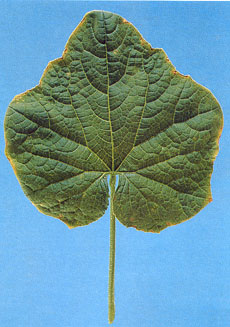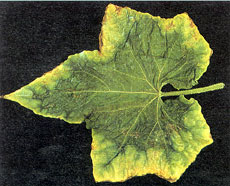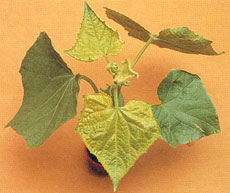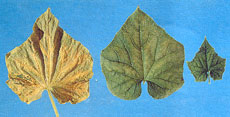
Nutrient disorders of greenhouse Lebanese cucumbers
Introduction
Although this Agfact has been prepared specifically for growers of Lebanese cucumbers, the descriptions and illustrations of leaf symptoms given here would be similar for other cucumber crops and for other cucurbits such as rockmelons, watermelons, pumpkins and gherkins.
The greenhouse Lebanese cucumber industry in the greater Sydney region is valued at more than $25 million a year on-farm. Crop losses of just 5% due to nutritional disorders can thus lose growers $1.25 million every year.
This Agfact has been written to help growers better identify and more effectively treat nutritional disorders so that fruit yield and quality losses are minimised.
Some greenhouse cucumber growers assume that symptoms of nutritional disorder are caused by diseases or pests. When growers act on this assumption, plant health, fruit yields and quality can suffer. An understanding of crop nutrient principles and the use of best fertiliser practices are keys to growing a healthy and thus profitable Lebanese or mini cucumber crop.
Whether you are growing the less vigorous, precocious varieties that crop heavily during a short cropping season, or the more vigorous varieties that require pruning and training and produce fruit more gradually during a longer season, you must test soil fertility before planting. That way, you can save fertiliser, achieve the best fruit yield and quality, and reduce environmental impacts.
Symptoms of nutritional disorders are often seen on the leaves and fruit of greenhouse cucumbers grown in the Sydney area. The two most common disorders are potassium deficiency, which causes yellowing between the veins of the oldest leaves, and boron deficiency, which causes yellow streaks and corky markings (scurfing) on the fruit.
Overuse of fertiliser gives rise to another common problem, evidenced by slightly droopy plants that have dull, leathery leaves and a thin yellow tinge around the margins of older leaves. Although fertiliser promotes healthy, robust plant growth and high yields, there is a point at which it becomes toxic and retards plant growth and fruit production. Applications should be based on regular soil and leaf tests and on leaf symptoms, and not on the belief that if some fertiliser is good, then more must be better.
Growers are generally unconcerned about leaf symptoms because the symptoms do not directly influence the market value of the crop. However, this ignores the fact that the same problems that cause the leaf symptoms can also reduce fruit production and quality. This is because the leaves manufacture the food needed by the plant to produce fruit, so if they are not healthy, then yield and quality can be reduced, and the cropping season can be shortened, especially for vigorous varieties.
An important fact is that plants produce leaf symptoms only when a nutritional problem has become serious. Often yield or quality has been significantly reduced before symptoms appear. Therefore, at the first sign of a problem you should identify and treat the disorder. Although you will not prevent production losses (and hence profit losses), you can minimise the extent and severity of fruit losses.
Identifying nutritional disorders
Visual diagnosis
Leaf symptoms give the quickest clue to the identity of a nutritional disorder in a crop. Plants respond to nutritional shortages and excesses by expressing characteristic symptoms for each problem. These symptoms can be used as the basis for diagnosis. Table 1 gives a quick guide for identifying the most common nutritional disorders of greenhouse cucumbers.
Table 1. Quick guide to the most common nutritional disorders of greenhouse cucumbers
| Deficiency | Symptoms |
|---|---|
| Symptoms first seen in older leaves—uniform leaf colour | |
| Nitrogen deficiency | Pale green to yellow leaves, stunted growth |
| Phosphorus deficiency | Leaves dull (lacking lustre), grey-green or purple; poor plant growth |
| Chloride toxicity | Wilting, dull, dark leathery leaves; edge yellowing |
| Symptoms first seen in older leaves—leaf colour change forms a pattern | |
| Potassium deficiency | Scorching and yellowing around the edges of leaves and between the main veins |
| Magnesium deficiency | Interveinal yellowing spreading deep within the leaf blade, followed by light tan burn |
| Manganese toxicity | Reddish spots between the veins and on petioles |
| Boron toxicity | A broad band of yellow tissue around the margins of the leaf; when severe, new leaves are chlorotic and distorted |
| Symptoms first seen in young leaves only—leaf colour change forms a pattern | |
| Iron deficiency | Clearing between veins, leaving faint green network (‘skeleton’) of veins on leaf |
| Zinc toxicity | Pale green chlorosis of new leaves and light-brown spots between the veins |
| Symptoms first seen in young and mature leaves—leaf colour change forms a pattern | |
| Manganese deficiency | Mottled, diffuse, pale green to yellow chlorosis highlighting veins |
| Symptoms first seen in fruit and growing points | |
| Calcium deficiency | Breakdown of fruit; death of growing points |
| Boron deficiency | Mottled yellow streaking and corkiness in fruit; distortion of new leaves; death of growing points |
Leaf analysis
Visual diagnosis of disorders can be confused by symptoms induced by non-nutritional factors such as disease, pests and chemicals. Leaf analysis can be used to confirm a visual diagnosis. This involves chemical testing of leaves to establish whether specific nutrients are present in plant tissue at normal concentrations. The technique can be used to check the suitability of a fertiliser program and to anticipate the need for nutrient supplements. A disadvantage of leaf analysis is that it is slow: most laboratories will take at least a week to process samples and report the results back to the grower. In many cases, laboratories do not interpret results or recommend how to remedy the situation.
Leaf analysis is based on a sample of the youngest fully mature leaf (with petiole) at the early flowering stage. Table 2 lists the standards used to interpret the leaf analysis report.
Table 2. Leaf analysis standards for cucumbers (youngest fully mature leaf with petiole taken at early flowering stage).
| Nutrient | Unit | Deficient | Low* | Normal | High* | Excess |
|---|---|---|---|---|---|---|
|
Nitrogen (N) | % | <1.8 | 1.8–2.5 | 2.5–4.5 | 4.5–6 | >6 |
|
Phosphorus (P) | % | <0.20 | 0.20–0.3 | 0.3–0.7 | 0.7–1.0 | >1.0 |
|
Potassium (K) | % | <2.0 | 2.0–2.5 | 2.5–4.0 | 4.0–5.0 | >5.0 |
|
Calcium (Ca) | % | <1.0 | 1.0–2.5 | 2.5–5.0 | ||
|
Magnesium (Mg) | % | <0.15 | 0.15–0.3 | 0.3–1.5 | 1.5–2.5 | >2.5 |
|
Sulphur (S) | % | <0.3 | 0.3–1.0 | |||
|
Sodium (Na) | % | 0–0.35 | >0.35 | |||
|
Chloride (Cl) | % | 0–1.5 | 1.5–2.0 | >2.0 | ||
|
Copper† (Cu) | mg/kg | <3 | 3–8 | 8–20 | 20–30 | >30 |
|
Zinc† (Zn) | mg/kg | <15 | 15–20 | 20–100 | 100–300 | >300 |
|
Manganese† (Mn) | mg/kg | <15 | 15–60 | 60–400 | 400–500 | >500 |
|
Iron (Fe) | mg/kg | ‡ | <50 | 50–300 | ||
|
Boron (B) | mg/kg | <20 | 20–30 | 30–70 | 70–100 | >100 |
|
Molybdenum (Mo) | mg/kg | <0.2 | 0.2–0.5 | 0.5–2.0 |
* Values in these columns are speculative. Values in the other columns have been established.
†Values for copper, zinc and manganese in leaves sprayed with fungicides or nutrient sprays containing trace elements cannot give a reliable guide to nutritional status.
‡ Leaf analysis is not a reliable guide to iron deficiency because of surface contamination with soil, immobility of iron within the plant, or the presence of physiologically inactive iron within tissues.
Major or macro-nutrient deficiencies
Nitrogen deficiency
Most plants need nitrogen in large amounts. It is generally considered to drive plant growth, probably because its supply is often limiting. A shortage of nitrogen reduces the plant's capacity to trap energy through photosynthesis. Nitrogen is required in the production of chlorophyll (the green pigment in leaves), which is responsible for converting sunlight to usable plant energy.
Both vegetative growth and fruit production are severely restricted when nitrogen supply is inadequate. Plants appear pale and spindly. New leaves are small but remain green, whereas the oldest leaves turn yellow and die. If the problem is not corrected, the yellowing spreads up the shoot to younger leaves. Yield is reduced and fruit are pale, short and thick.
Treatment
Side-dress deficient in-ground crops with 20–50 kg N/ha, or apply fortnightly foliar sprays of 2% urea at high volume. To prevent possible salt burn to leaves when applying any foliar spray, spray late in the afternoon or during cloudy weather.
For crops grown in soilless media, use a nutrient solution containing 150–200 ppm N.
Phosphorus deficiency
Australian soils generally are low in phosphorus, so they must be regularly supplemented with fertiliser. Plants require phosphorus at all stages of growth, but demand is greatest during crop establishment and early plant growth. If phosphorus becomes limiting, it is translocated from older to younger tissues, such as the leaves, roots and growing points. In a crop such as cucumbers, which has a succession of new vegetative and fruiting tissues, a regular supply of phosphorus (and other elements) is needed to ensure that the plant can sustain quality fruit production over a prolonged period.
Phosphorus-deficient plants have weak roots, are stunted, and produce small, dark, dull, grey-green leaves. The oldest leaf, at the base of the shoot, turns bright yellow. However, unlike nitrogen deficiency, the leaf directly above this leaf remains dark green. Brown patches appear between the veins on mature leaves. These become scorched and spread until the leaf dies prematurely. Fruit set is reduced and so production is impaired.
Treatment
Soil-grown crops will not respond rapidly to side-dressings or to foliar sprays. To benefit a crop, phosphorus fertiliser must be added to the soil before planting. A soil test is therefore essential to establish the soil’s phosphorus status and to estimate how much (if any) phosphorus fertiliser is required. A soluble phosphorus source such as monopotassium phosphate can be supplied through irrigation (‘fertigation’) to revive established crops with symptoms, but any fertigation or foliar treatment is only a short-term or ‘Band-Aid’ cure and is unlikely to be very effective in the long term.
For crops grown in soilless media, use a nutrient solution containing 25–50 ppm P.
Potassium deficiency
Potassium deficiency influences plant water regulation by affecting cell turgor and the opening and closing of stomata. Deficient crops are prone to wilting.
As potassium is mobile in the plant, it moves to the younger leaves when supplies are short. Although the growth of deficient plants may not be seriously impaired, the yield and quality of fruit are often greatly reduced.
Potassium deficiency causes yellowing and scorching of older leaves. These symptoms begin at the margins of the leaf and spread between the veins towards its centre. Large areas of tissue around the major veins remain green until the disorder is well advanced. A brown scorch develops in the yellow areas and spreads until the leaf is dry and papery. As each leaf dies, others further up the shoot develop the same symptoms. These symptoms can develop rapidly in hot weather. Fruit may not expand fully at the stem end, although they look swollen at the tip end, a symptom that is also caused by water stress.
Treatment
Potassium from a fertiliser side-dressing will move from the soil surface to the roots only if the soil is very sandy. Potassium fertilisers are therefore best incorporated in the soil before planting. A soil test can be used to determine the rate needed. Fertigation or drip feeding can also be used to treat a deficient crop. Foliar sprays are less effective and can burn leaves.
For crops grown in soilless media, use a nutrient solution containing 150–200 ppm K.
Calcium deficiency
Calcium is important for the functioning of cell membranes and the strength of cell walls. Most calcium-related disorders of crops are caused by unfavourable growing conditions and not by inadequate supply of calcium to the roots. Rapidly growing crops in hot windy conditions are most at risk. Deficiencies can also develop when cucumbers grow quickly under continuously humid conditions, as in a polyhouse. Other contributing factors are waterlogging, soil salinity, high potassium or ammonium supply, and root disease.
Calcium moves in the plant’s transpiration stream and is deposited mainly in the older leaves. Deficiencies are found in the youngest leaves and growing points, which have low rates of transpiration. Emerging leaves appear scorched and distorted and may cup downwards because the leaf margins have failed to expand fully. Mature and older leaves are generally unaffected. With a severe deficiency, flowers can abort, and the growing point may die. Fruits from calcium-deficient plants are smaller and tasteless, and may fail to develop normally at the blossom end.
Treatment
Injury from calcium deficiency can be reduced by regular foliar sprays of calcium nitrate (800 g/100 L). Apply lime to acidic soils and reduce the use of ammonium-based or potassium-based fertilisers.
For crops grown in soilless media, use a nutrient solution containing 150–200 ppm Ca. Keep the conductivity of water in the growing medium below 2 dS/m as the incidence of deficiency increases with increasing conductivity.
Magnesium deficiency
Magnesium is a constituent of chlorophyll. Deficiency is most likely on coarse-textured soils in humid regions, and especially on light, sandy, acidic soils in higher-rainfall areas. Magnesium deficiency can be induced by heavy rates of potassium fertilisers. Symptoms are more likely to show during cold weather or on heavy wet soils, when roots are less active.
Magnesium deficiency causes yellowing of older leaves. The symptom begins between the major veins, which retain a narrow green border. A light tan burn will develop in the yellow regions if the deficiency is severe. Fruit yields are reduced.
Treatment
Incorporate magnesite (300 kg/ha) or dolomite (800 kg/ha) into deficient soils before planting. Fortnightly foliar sprays of magnesium sulphate (2 kg/100 L) at high volume (500–1000 L /ha) should control a deficiency in a current crop.
For crops grown in soilless media, use a nutrient solution containing 30 ppm Mg.
Trace or micro-nutrient deficiencies
Manganese deficiency
The function of manganese in the plant is closely associated with the function of iron, copper and zinc as enzyme catalysts. Manganese is needed for photosynthesis, respiration and nitrate assimilation. Deficiencies are more likely in calcareous or alkaline soils, or over-limed soils; availability is high in acidic soils.
The veins of middle to upper leaves of manganese-deficient plants appear green against the mottled pale green to yellow of the blade.
Treatment
Spray the foliage with manganese sulphate (100 g/100 L).
For crops grown in soilless media, use a nutrient solution containing 0.3 ppm Mn.
Iron deficiency
Iron is needed to produce chlorophyll and to activate several enzymes, especially those involved in photosynthesis and respiration. Deficiencies of iron are more likely in alkaline or calcareous soils, and can be induced by over-liming, poor drainage, or high concentrations of metallic ions in the soil or nutrient solution. Iron availability decreases at pHs above 7. Manganese toxicity can induce an iron deficiency.
Iron deficiency causes a uniform pale green chlorosis of the newest leaves; all other leaves remain dark green. Initially, the veins remain green, which gives a net-like pattern. If the deficiency is severe, the minor veins also fade, and the leaves may eventually burn, especially if exposed to strong sunlight.
Treatment
Good drainage and soil aeration favour iron availability.
Foliar sprays of iron sulphate (150 g/100 L) can be used to treat symptoms, but symptoms will return if the sprays are discontinued. The best long-term action is to correct soil chemical and physical problems.
For crops grown in soilless media, use a nutrient solution containing 2–3 ppm Fe. Iron chelates are generally less likely to precipitate under alkaline conditions and are normally preferred in hydroponic solutions.
Boron deficiency
Plants are rather exacting in their requirements for boron, and the margin between deficiency and excess is particularly narrow. For example, in mini cucumbers, a leaf boron concentration of 30–70 µg/g is desirable, but deficiency occurs at less than 20 µg/g and toxicity at more than 100 µg/g.
Boron is not readily moved from old to new tissues, hence continuous uptake by roots is needed for normal plant growth. Boron is important in the regulation of developing cells and in pollination. Seed set and fruit development are affected by deficiency.
Boron deficiency causes both leaf and fruit symptoms. The main leaf symptoms are a distortion of newer leaves (in severe cases the growing point dies) and the appearance of a broad yellow border at the margins of the oldest leaves. Young fruit can die or abort; abortion rates are high. The symptoms of boron deficiency on mature fruit are distinctive and include stunted development and mottled yellow longitudinal streaks, which develop into corky markings (scurfing) along the skin. These symptoms are often most severe near the blossom end of the fruit. Similar symptoms can occur on fruit grown in polyhouses with inadequate winter heating. Developing and mature fruit can taper and curve at the blossom end. The proportion of pith to seed is often higher in boron-deficient fruit.
Do not confuse symptoms of fruit scurfing and severe twisting with damage by western flower thrips.
Treatment
Be very careful when treating a boron-deficient crop, as boron is highly toxic to most plants at quite low rates. Trial foliar sprays are advisable. Take care with soil treatments to ensure an even spread, and be aware that excess boron can be toxic.
An application of 10 kg borax per hectare to deficient soil before planting will prevent boron deficiency. Foliar sprays of borax (100 g/100 L) may also be used.
For crops grown in soilless media, use a nutrient solution containing 0.3 ppm B.
Nutritional toxicities
Excess fertiliser (excess salt)
Cucumbers are sensitive to excess fertiliser, which increases soil salinity and causes toxicity, usually from nitrogen.
Plants grown under saline conditions, where the soil or growing medium has high electrical conductivity (EC), are stunted and produce dark green, dull, leathery leaves that are prone to wilting. A narrow band of yellow necrotic tissue is often present on leaf edges. This can affect leaf expansion, causing a slight downward cupping of the leaf. After a serious water stress, the oldest leaves may develop a uniform pale green chlorosis and small necrotic areas within the leaf. If water supply is maintained, leaves may only develop a band of pale green tissue around their edges. Plants are likely to wilt in warm weather.

Treatment
Leach the soil or growing medium with fresh water until the excess fertiliser is removed. Adjust the fertiliser program to ensure that rates do not exceed crop needs.
Excess nitrogen
Plants given too much nitrogen are generally stunted and have strong, thick stems, short internodes, a mass of tendrils, short side shoots, fewer flowers, and small fruit. The middle and older leaves cup downwards and wilt easily in warm conditions. Leaf scorching is common. Transparent spots occur between the veins or at the leaf edges, which eventually turn yellow and then brown.
Treatment
Leach the soil or growing medium with fresh water to remove the excess fertiliser. Adjust the fertiliser program to ensure that rates do not exceed crop needs.
Chloride toxicity

Cucumbers are moderately sensitive to chloride. Chloride salts are common in the soil or groundwater in areas on Wianamatta Shale (for example, around Glenorie and Blacktown in NSW). Chloride is also present in fertilisers, such as muriate of potash (potassium chloride). Do not use these fertilisers if salt is a problem.
Chloride toxicity reduces plant vigour and causes yellowing and scorching of leaf margins, and premature leaf fall.
Test the sodium and chloride content of the soil and water supply before embarking on cucumber growing.
Treatment
Leach the soil or growing medium with fresh water to remove the salts. Identify sources of chloride and take appropriate steps to prevent a recurrence of the problem. Check water quality and soil salinity regularly.
Moderately saline water can be used for soil-grown crops provided irrigation is done at night, is infrequent and supplies a large volume of water. Irrigate regularly with fresh water to remove the accumulated salts from the soil.
Boron toxicity
Cucumber plants are very sensitive to high boron levels. In fact, boron compounds have been used as herbicides.
Boron toxicity is indicated by yellowing between the veins of older leaves. This is followed quickly by the development of small, brown necrotic spots, which eventually join to form large areas of dead tissue. At the same time, the newer leaves become chlorotic and are distorted because of damage in the bud. Few female flowers may develop.
Treatment
Boron toxicities are harder to correct than deficiencies. Problems in crops are usually caused by careless application of boron. When this happens, the soil can be flushed with fresh water to remove the excess.
If applying borax to the soil surface, ensure that all lumps are broken up to avoid pockets of high concentration near plant roots. Follow the manufacturers' instructions carefully when supplying boron to crops.
Manganese toxicity
Cucumbers are not particularly sensitive to excess manganese, and high tissue concentrations are needed before toxicity symptoms show. Manganese toxicity can be recognised from the appearance of numerous small, reddish-brown spots between the veins of the oldest leaves and on leaf petioles. In time, the tissue around each spot becomes chlorotic, and the older leaves turn pale and age prematurely. Manganese toxicity can induce iron deficiency.
Treatment
Manganese toxicity in soil-grown crops is associated with acidic conditions and waterlogging. Correction therefore involves liming and improving drainage and irrigation scheduling.
Zinc toxicity
Zinc toxicity causes a pale green chlorosis of newer leaves. If toxicity is severe, pinhead-sized light-brown spots may appear between the veins. Older leaves may wilt and appear dull. All leaves are a lighter green than is normal.
Treatment
Zinc toxicity can be caused by contamination of the water used in soilless culture. Contact of corrosive nutrient solutions with galvanised pipes or fittings has been known to lead to zinc toxicity in sensitive seedlings. Galvanised polyhouse frames and wires are other possible sources of excess zinc.
Take care to use zinc supplements only as recommended by the manufacturer.
Other causes of leaf disorders
 |  |

